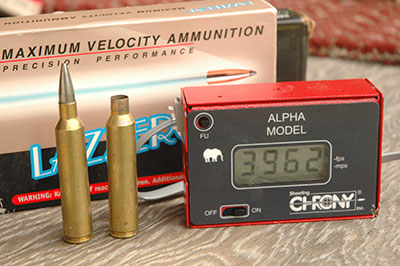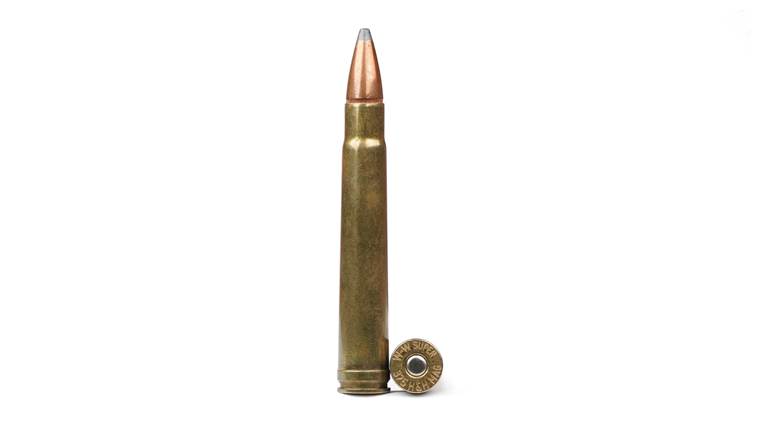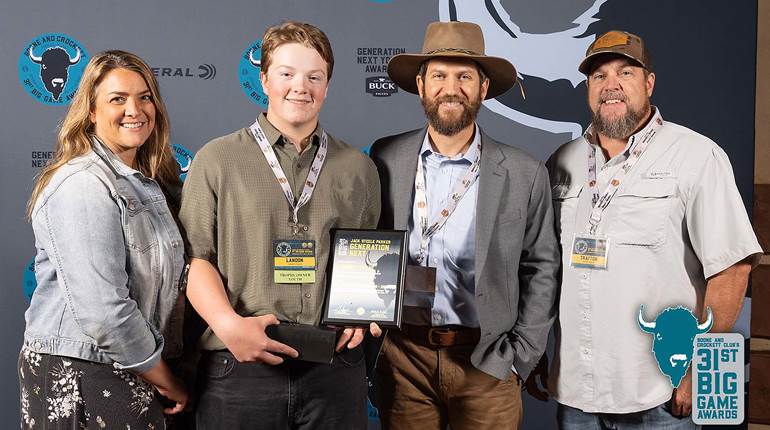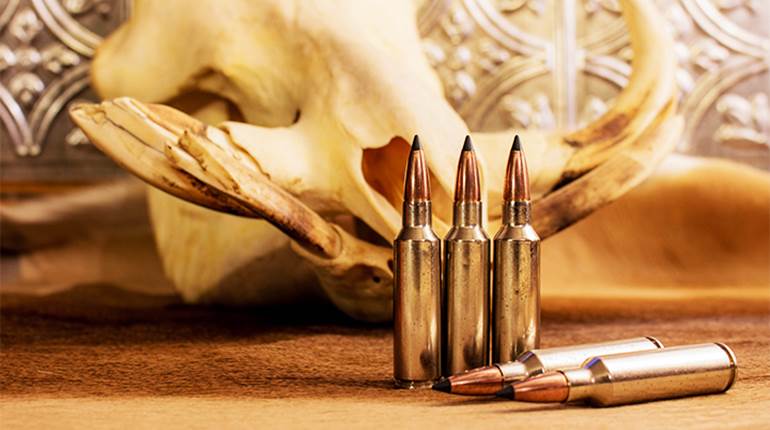
Examples from past magnum cartridge crazes include (l. to r.): a vintage “Super Speed”-headstamped .375 H&H Mag., Hornady’s .375 Ruger, a .300 Remington Ultra Mag. and the .300 Winchester Short Magnum.
Historically, American shooters crave accuracy and velocity—perhaps more of either than is really required. Sure, if you’re into competitive shooting, varmint hunting or anything at long range then you need all the accuracy you can get. But millions of American hunters don’t need sub-minute-of-angle (m.o.a.) groups. We need enough accuracy to center the vitals of a deer, which is not a small target. Many of us, as mandated by local law, get by fine with slug guns—many more do nicely with good old .30-30 Winchesters. Neither platform is likely to win benchrest or 1,000-yd. matches, but both account for plenty of venison.
Velocity is also seductive. Velocity flattens trajectories, and since the equation that derives foot-pounds of energy squares velocity, energy yields go up quickly as velocity increases. So, velocity looks good on paper, but extreme velocity is often an enemy to both accuracy and bullet performance. Velocity also increases recoil and muzzle blast. That’s okay if you really need the speed; you have to get the bullet where it needs to go, and it needs to get there with enough residual energy to do its necessary work.
Allow me to present you with one fact and one theory. The fact is that gravity acts on all projectiles as soon as they leave the muzzle, so all trajectories are curved. Bullet aerodynamics count heavily, and so does your short-range zero, but at some distance, no matter what your initial velocity, you are going to have to adjust your hold to compensate for bullet drop. When this happens you must know your trajectory. Absent an inordinately high 100-yd. zero, this point occurs no farther than 300 yds., even with our fastest cartridges. At whatever range holdover is required, trajectory becomes just a number—and you must know that number.
The theory is something I can’t prove because I can’t ask game animals. But I don’t believe they can distinguish between small differences in our increments of measure—whether a few hundred feet per second of velocity or foot-pounds of energy—or between a few thousandths in bullet diameter or a few grains of bullet weight. On targets, whether live or inanimate, only hits matter. And on game animals, particularly, bullet performance and shot placement are more important than the bullet’s velocity and how much energy it delivered.
We have gone through phases, what I call “magnum crazes,” where many of us bought into the concept that it was essential for our bullets to arrive “firstest with the mostest.” Since it’s happened twice during my lifetime, it may happen again, but there is evidence that today’s shooters are starting to place more emphasis on efficiency.
So, What Is A “Magnum”?
The British started this business of cartridge buzzwords. In the 1880s it was discovered that heavy charges of blackpowder behind light-for-caliber projectiles boosted velocities from a norm of 1400 f.p.s. to well over 1800 f.p.s. These were called “express” loads after the new, fast express trains. A few years later, smokeless powder further upped the ante (initially to just more than 2000 f.p.s.)—the Brits called these loads “Nitro Express.”
“Express” is still occasionally used as a cartridge buzzword, but “magnum” made its debut before “nitro”—and it also started with the British. A “magnum” is an extra-large bottle of champagne, so a magnum cartridge used a larger case, holding more powder. In the British gun trade a “magnum cartridge” was, initially, a larger case based on a pre-existing bullet diameter. John Rigby introduced the rimmed .400/.350 cartridge in 1899. In 1908, he introduced the rimless .350 Rigby Magnum. In 1911, he introduced the .416 Rigby. Although large-cased and fast, he didn’t call it a “magnum” because it was his first .416-cal. cartridge.
In 1905, Holland & Holland introduced the mild .400/.375 Nitro Express. It didn’t sell, so Hollands tried again in 1912 with the .375 H&H Magnum. The .400/.375 was the first commercial cartridge to wear a belt. The .375 H&H Mag. is also belted, and to this day serves as the parent case for most “belted magnums.” For years we figured a magnum cartridge had to wear a belt, and that a belted cartridge was a magnum. Thanks to the Remington Ultra Magnum (RUM), Remington Compact Magnum (RCM), Remington Short Action Ultra Magnum (RSAUM), Winchester Short Magnum (WSM), and Winchester Super Short Magnum (WSSM) cartridges, that concept has gone by the wayside, but “magnum” continues to suggest velocity and power.

The First Magnum Craze: 1956-1966
Although other buzzwords were used (High-Power, Swift, Zipper, etc.), the first commercial American rifle cartridge to be called a “magnum” was the .458 Winchester Magnum introduced in 1956. This had already been done in handgun cartridges with the .357 S&W Magnum in 1935 and with the .44 Remington Magnum in 1955. In the rifle world the .458 Win. Mag. was first, but there were precursors. Several British magnums (.275, .300 and .375 H&H) were loaded in the United States. There were also proprietaries, such as the .350 Griffin & Howe Magnum, but I suspect it was Roy Weatherby’s line of belted magnums—or, more to the point, the press Roy’s cartridges were generating—that got things going.

In the old sense one might ask exactly what Winchester cartridge the .458 was a magnum version of? Perhaps the .45-75? But let’s not split hairs. For the following decade, most new American rifle cartridges wore belts and were called magnums. The year 1958 saw the .264 and .338 Win. Mags., along with the .222 Rem. Mag., an unbelted exception but clearly a larger (thus “magnum”) version of the .222 Rem. The 7 mm Rem. Mag. came along in 1962, followed by the .300 Win. Mag. in 1963. Roy Weatherby’s line also expanded during that period with the .224, .340 and .460 Weatherby Magnums, which were all belted, but, unusually, on three distinct case diameters.
Magnums were “in,” and it appeared that any cartridge carrying the magnum suffix was sure to be a winner. It’s hard to say exactly when this ended. The pipeline was full, with most caliber niches covered, but I’m going to pick 1966 because that was the year Remington introduced its 6.5 mm Rem. Mag., following its .350 Rem. Mag. Although belted, both were true short magnums for short bolt-actions. They were thus efficient little cartridges and ahead of their time, but neither sold well. This must have come as a huge wakeup call for the industry: The word “magnum” was no longer magic.
For quite some time there were few new magnums. An exception was 1978’s 8 mm Rem. Mag., but it also didn’t sell very well. Of course, many of us owned the brave new belted magnums and used them with relish. There were also some new “non-magnum” cartridges that did well, such as the .22-250 Rem. (1965) and 7 mm-08 Rem. (1980). But a lot of us stuck with, or returned to, old favorites, including the .243 Win., .270 Win., .308 Win. and .30-’06 Sprg.

The Second Magnum Craze: 1998-2004
Fast-forward to 1998. Starting with the .300 RUM, in the span of just six years Remington and Winchester asked the market to embrace fully 13 long, short and super-short unbelted “magnums.” There was never any magic to a belted case. John Rigby knew this. So did Charles Newton: His unbelted .250 Savage (p. 58) was the first commercial cartridge to break 3000 f.p.s.; his own .256, .30 and .35 Newton were commercial flops, but they were fast, efficient and unbelted—and all could have been called “magnums.”
John Lazzeroni was the real instigator of our second magnum craze. A long-time wildcatter, “Lazz” created his own extensive line of both long and short unbelted magnums with whimsical names: Warbird, Titan, Scramjet, Firebird and a dozen more. Over the years, Weatherby’s proprietary hold on Weatherby Magnum cartridges has eased, with other manufacturers making rifles and loading ammunition. Lazzeroni’s propriety has stayed pretty tight, in part because his case diameters are a bit too fat for existing commercial actions. The parallel with Roy Weatherby holds because, in the early 1990s, Lazz, also a very good marketer, was garnering a lot of headlines and making the major manufacturers nervous.
They responded—perhaps a bit too loudly. Winchester followed the full-length .300 RUM with the .300 WSM. Remington countered with more RUMs and the RSAUMs for the Model Seven action. Winchester added more WSMs, and then WSSMs. In half the time the shooting market had to digest double the number of new magnums that were introduced during that first magnum craze. There had to be winners and losers, and this is still sorting itself out. None of these brave new magnums are breaking sales records, but a few are now established; others have set records for early deaths.
Interestingly, in recent years many cartridges that might formerly have been termed “magnums” are not so named. Good examples include the .375 and .416 Ruger, and the growing family of Nosler cartridges. These are all good cartridges occupying important niches, but it seems obvious that the word “magnum” was not considered essential to marketing efforts. And there is evidence that our tastes in cartridges have shifted back toward mild-mannered efficiency.
The Creedmoor Craze
We have seen some new cartridges take off and others languish. Those such as the .264 Win. Mag., took off like rockets and then fizzled. The 6.5 mm Creedmoor (Sept. 2017, p. 56) is an unprecedented phenomenon. Introduced a decade ago to “ho hum” reception, it languished for eight years. Only a few competitive shooters cared. Then it skyrocketed! Suddenly everybody wanted one, and everybody was making it.
On the one hand, it’s a sea change: The 6.5 mm Creedmoor is the embodiment of a mild-mannered, effective and highly accurate little cartridge. On the other hand, I don’t get it. The Creedmoor was designed as a long-range target cartridge. Its short case offers the ability to seat long bullets out, yet still use a short-action. When mated with aerodynamic, long-for-caliber .264" bullets, its moderate velocity enables it to be supersonic to well beyond 1,000 yds. It’s also a great deer cartridge, but because of diameter, energy and bullet weight, it’s not always embraced as a long-range hunting cartridge.
Also, it isn’t a new concept. As a hunting cartridge it’s no better than 1891’s 6.5x55 mm Swedish Mauser. As a long-range target cartridge, only individual barrels can determine whether it’s better than the similar .260 Rem. or the faster 6.5-.284 Norma. Before the Creedmoor craze you could barely give away 6.5 mms in this country, but their advantages (and disadvantages) haven’t changed. It’s a phenomenon that I can’t fully explain.
The “AR Effect”
The popularity of the AR (and similar) platforms is having a huge impact on our tastes in rifles and cartridges. Bolt-actions and single-shots can be sized to house almost anything. The AR-15 platform is built around the .223 Rem./5.56x45 mm NATO cartridges, and the AR-10 platform is built around the .308 Win./7.62x51 mm NATO cartridges. Both actions offer little leeway to expand beyond those families. NEMO’s oversize AR-10 in .300 Win. Mag. is famous, but among standard lowers and uppers, AR-15 and AR-10 frames are held to finite families of cartridges.
So, consistently, if you look at sales figures for both rifles and ammunition, among center-fires you’re going to find .223/5.56 mm at the top. Depending on which figures you look at, the .308/7.62 mm usually isn’t far behind. Amazing as it may seem, however, cartridges such as the 6.5 mm Grendel, .300 Blackout and 7.62x39 mm often place far ahead of “conventional sporting cartridges” in sales. Among Hornady’s top-selling reloading dies, for instance, .223 is second, .308 is third, .300 Blackout is fourth and 6.5 mm Grendel is eighth. If you’re an AR guy you’re nodding your head. If you’re not, this is probably surprising; but the cartridge that comes first in Hornady’s recent die sales is—you guessed it—6.5 mm Creedmoor.
Hard Data
Sales data is elusive, because specifics are confidential, and evasive, because no manufacturer makes everything. No outlet sells everything either, and customer bases differ. Still, I managed to come up with data from some major distributors. And, not surprisingly, .22 Long Rifle beats everything, quickly followed by 12 gauge and 9 mm Luger. This was consistent. Also consistent: .223/5.56x45 NATO is the top-selling center-fire in rifles and ammunition, followed by the .308/7.62 mm. In part this is the “AR effect.” Also reflected in the number is inexpensive ammunition for both, but we should agree that the .223 Rem. is a super varmint cartridge and the .308 Win. is a versatile big-game cartridge.
After that, things get interesting. On the sales lists of two major outlets the 6.5 mm Creedmoor is third. Across the board, you have to scroll down quite a bit before you come to any magnum cartridge. Then you have to keep going before you get to another one. Consistently, the .300 Win. Mag. is the most popular magnum cartridge, eighth (among center-fire rifle cartridges) on one list, 10th on another, and so forth. Usually the 7 mm Rem. Mag. comes in a bit later, but on one list the .338 Lapua Mag. is 10th, and the 7 mm Rem. Mag. is much farther down.
Listings vary, but rifle cartridges that beat out all magnums except the .300 Win. Mag. and 7 mm Rem. Mag. include: .223/5.56 mm, .308/7.62 mm, 6.5 mm Creedmoor, .22-250 Rem., .243 Win., .270 Win., and .30-’06 Sprg. These I expected, but there were surprises, including .30-30 Win., .35 Whelen and .45-70 Gov’t. The 7 mm-08 Rem. doesn’t usually beat the .300 Win. Mag., but it generally beats the 7 mm Rem. Mag.

A “Non-Magnum” Era?
This is an age of specialization. Cartridges designed to fit ARs are adapted to other actions, but are somewhat specialized by their primary platforms. Cartridges such as the .22-250 Rem. and .243 Win. cross over between varmints and deer-sized game, but are questionable for larger game. The .30-30 Win., .35 Whelen and .45-70 Gov’t are useful cartridges, but, given all the hype about long-range shooting, they don’t fit that scenario.
The .270 Win. and .30-’06 Sprg. are versatile hunting cartridges, period. Likewise, but, in my opinion, to a slightly lesser degree, the 6.5 mm Creedmoor, 7 mm-08 Rem. and .308 Win., though these offer the advantages of short actions. Fifty years ago, Jack O’Connor commented that the 7 mm Rem. Mag. wouldn’t do anything his beloved .270 Win. couldn’t do. I’ve used the 7 mm Rem. Mag. a lot, it’s a great cartridge, but today I think the Professor was right. The Big Seven burns more powder and has more blast, but it’s similar in performance to the .270, with just 0.007" difference in bullet diameter. I’m also convinced it’s not as hard-hitting as the .30-’06 Sprg. For years it was the world’s most popular magnum; perhaps these thoughts explain why it has slipped.
At the same time, the .300 Win. Mag. has come to the fore as our most popular magnum. A fast .30-cal. is exceptionally versatile. I have used them all, and lately I’ve used the .300 Win. Mag. a lot. It’s awesome, but not everyone needs this level of performance, nor would everyone be comfortable with the attendant recoil and blast. A lot of folks must have come to this conclusion as well, because .300 Win. Mag. is currently the only genuinely popular magnum cartridge—none of the brave new unbelted magnums, and none of the older belted magnums come close.
In fairness, above .30-cal. sales drop fast; most of us don’t need larger calibers. However, there are three anomalies in the data I’ve seen: .35 Whelen and .45-70 Gov’t for, my guess, early season hunters who are allowed straight-walled or antique cases, and close-cover hunters who prefer to use larger, heavier bullets on game. Also, more surprisingly, the .338 Lapua Mag. is strong in some sales reports.
In the main, it seems that our traditional, gold-standard non-magnum hunting cartridges—.243 Win., .270 Win., .308 Win. and .30-’06 Sprg., plus the 6.5 mm Creedmoor—are going strong. A majority who desire more performance seem to settle on the .300 Win. Mag.—a true magnum in every sense, but not our fastest. Still, it’s by far the most available. It stands tall as a sentinel that proclaims, “The magnum isn’t dead!”





































